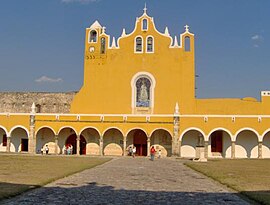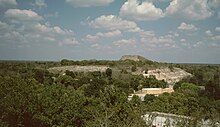Izamal
| Izamal | ||
|---|---|---|
|
Coordinates: 20 ° 56 ' N , 89 ° 1' W Izamal on the map of Yucatán
|
||
| Basic data | ||
| Country | Mexico | |
| State | Yucatan | |
| Municipio | Izamal | |
| Residents | 16,195 (2010) | |
| City insignia | ||
| Detailed data | ||
| height | 12 m | |
| Post Code | 97540 | |
| prefix | (+52) 988 | |
| Time zone | UTC −6 | |
| City Presidency | Warnel May Escobar | |
| Website | ||
| Church and convent | ||
Izamal (in Mayathan Itzmal , "place of the iguanas") is a historically important small town in the state of Yucatán in Mexico . Izamal has about 16,000 inhabitants and is the administrative seat of the Municipio Izamal .
The history of the city goes far back to pre-Hispanic times, from which large pyramid-like structures have been preserved, and has retained its importance to the present day. The city received the Pueblo Mágico tourist award .
Pre-Hispanic period and preserved buildings
The earliest traces of the Indian city go back to the Middle Preclassic . In the early classical period, the city reached an area of around 10 km², although loose development must be considered. Two Sacbés led from Izamal to the places (and ruins) Aké , almost 30 km away in the west and, largely covered by a modern road, to Kantunil in the south. A small piece of the road to Aké, which is mostly recognizable in the terrain as a low elevation with slightly different vegetation and runs closely parallel to the modern city, was restored around 3.25 km west of the city center. A third street, only 1 km long, leads in a south-westerly direction to a pyramid platform, called Chaltunhá, on the modern outskirts. In the center of the modern place are several large and high platforms that once supported the temples of important deities . The structure of the city is comparable to T'ho, the pre-Hispanic Mérida . The pyramid platforms (except for the first two) and other pre-Hispanic buildings are in the gardens of the houses and cannot be seen from the streets.
P'ap'hol-chaak
This building became the foundation of the current Franciscan convent. The original shape of this pyramid structure is uncertain because it was redesigned to become the forecourt of the monastery church, which therefore rises several meters above the level of the streets. The entrances built here in the form of ramps certainly have nothing to do with the original shape. In order to align the church and monastery to the height of the atrium, high wall constructions were necessary, especially on the south side of the church.
Kinich Kak Moo
This pyramid platform is the largest in Izamal with sides of 200 m and a platform height of 36 m, it comes from the Middle Classical period. The main access to the platform is from the south side, where a monumental megalithic staircase made of huge carved stone blocks is far in front. Steep, but not monolithic, stairs lead up to the platform surface from the other sides. On the northern edge of the pyramid platform rises a pyramid with slightly rounded corners and 10 steps (50 × 30 m), which is considered post-classical and therefore several centuries younger than the pyramid platform. The complex was explored and restored in the 1990s under the direction of Luis Millet.
Kabul
This pyramid platform is a rather smaller construction on the west side of what is supposed to be a large space between the two above-mentioned pyramid platforms. On one of the buildings, John Lloyd Stephens and his draftsman Frederick Catherwood saw a large stucco mask in 1842, which is not unusual for early classical Maya buildings. Forty years later, Désiré Charnay found another mask and other stucco decorations. None of this has survived. Excavations and reconstructions have not yet taken place here. From here the Sacbé to Aké begins .
Itzamatul
The 21 m high platform (located on Calle 26) carried a temple for the god Itzamná . The northern and eastern sides have been restored and show a five-tier structure.
Habuc
A largely excavated complex of nested buildings in several construction phases, located on Calle 24.
El Conejo
The structure excavated and consolidated in 1994 (calle 22 near calle 33) is a relatively small platform with little building remains.
Pre-Hispanic story
In the last centuries before the Spanish conquest, Izamal belonged to the principality of Ah Kin Chel , which extended around 70 km inland from the central part of the north coast of the Yucatán. Its main town was Tekoh .
Colonial times
The area of Ah Kin Chel had surrendered to the Spaniards without fighting or resistance, and the large population was greatly reduced by two epidemics. In 1549 a Franciscan monastery was built on the platform of the main pre-Hispanic pyramid. The town, which was relatively small at the time of the conquest, was greatly expanded in the middle of the 16th century by the resettlement of the population, who were scattered over the area and who lived in politically separate districts for some time. Auxiliary troops of the Spaniards from central Mexico also settled in Izamal in a small settlement called La Concepción, which retained their native language for a few decades.
Modern city
Izamal was one of the most important cities in the Yucatán after the independence of Mexico. This can be seen in the fact that in the Yucatán flag, which was only used for a short time, Izamal was represented by a star in the green field, as was Mérida , Valladolid , Tekax and Campeche . The Spanish settlement was elevated to the rank of a villa in 1823 and a ciudad in 1841 , which it lost in 1923, only to be regained in 1981.
See also
Individual evidence
- ^ Ralph L. Roys : The political geography of the Yucatan Maya , Washington, Carnegie Institution 1957
- ^ Peter Gerhard: The southeast frontier of New Spain . Princeton, Princeton University Press 1979. ISBN 0-691-05273-5






